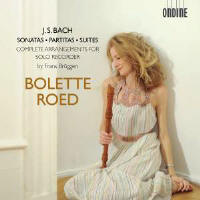Texte paru dans: / Appeared in: |
|
|
Outil de traduction ~ (Très approximatif) |
|
|
Reviewer: Raymond
Tuttle
I am not surprised that
someone arranged Bach’s iconic Solo Cello Suites, and his equally iconic
Sonatas and Partitas for Solo Violin, for a recorder, and who better to do
it than Frans Brüggen, who passed away in 2014? (Did you know? Such
information usually is not headline news.) Brüggen’s arrangements date from
the mid-1970s, and perhaps I have encountered a movement here and there, but
I cannot remember a recording in which two discs were devoted entirely to
them. (I see now that recorder virtuosa Marion Verbruggen has recorded all
six cello suites in arrangements of her own for the Harmonia Mundi label.
Brüggen himself recorded some of his arrangements, although I have not heard
them, or at least do not remember them.) I feel that if we wait long enough,
this music will be performed at least once on every possible instrument, and
even on some that are impossible.
Bolette Roed describes having
scouted out the right place to record these arrangements, and the right
recorders to play them on. The place was a church which is part of the
Augustenborg Castle on a Danish island. She plays no less than seven
different recorders on the first disc, which is devoted to the sonata and
partita movements. They are boxwood instruments of various sizes. On the
second disc, devoted entirely to the cello suites, she plays just one
instrument, a boxwood voiceflute. There are multiple differences between a violin (or a cello) and a recorder. Recorders cannot play chords (unless you count overtones) but violins and cellos can. Recorder players produce notes using air, not by rubbing a bow across their instrument, or by plucking a string. (If you blow across a cello string, people will look at you funny.) Everyone has to breathe sometimes, but for recorder players, producing a tone is tied into the process of respiration. A cellist can play Bach’s cello suites even if he or she is wearing a gas mask. Also, string instruments have a greater dynamic range than recorders, their sound has more weight, and their pitch is more controlled. That doesn’t mean that you shouldn’t play these works on a recorder, or that listeners should steer clear of this set. It simply means that you should adjust your expectations accordingly, and perhaps not plan to listen to all of this in one sitting.
Bolette Roed makes an
excellent case for these arrangements, it must be admitted. She shapes the
phrases engagingly and creates variety where she can. Even on lower,
sustained notes, her instruments hold pitch and are admirably steady in tone
production. You never feel as if you are about to drift into another key
signature. According to her booklet note, Roed has spent literally decades
digesting these works, and psyching herself up to play and record Brüggen’s
arrangements. Her experience shows. Nothing about these performances
suggests brute force, weakness, or lack of ability or forethought. This release is not just for recorder players, but it helps to be one! If you’re not a regular listener to this instrument, you might feel as if you have bitten off more than you chew, but these discs are fascinating in smaller serving sizes, thanks in no small part to Roed’s expertise, and to Brüggen’s legacy. | |
|
Support us financially by purchasing this disc from eiher one of these suppliers. Un achat via l'un ou l'autre des fournisseurs proposés contribue à défrayer les coûts d'exploitation de ce site. |
|
|
|
|
|
Cliquez l'un ou l'autre
bouton pour découvrir bien d'autres critiques de CD |
|




